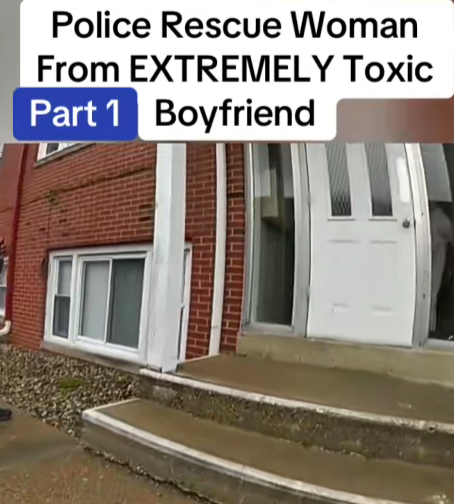A tense police rescue has captured widespread attention after officers responded to a call involving a woman trapped in what authorities described as an “extremely toxic” and dangerous relationship. Bodycam footage from the scene shows officers approaching a brick apartment building before entering to confront the volatile situation inside.
According to reports, the woman had been living under increasingly controlling and emotionally abusive conditions at the hands of her boyfriend. Neighbors and concerned friends eventually contacted authorities after noticing repeated loud arguments, cries for help, and signs that the woman was not safe. When officers arrived, they immediately recognized the seriousness of the situation.
Inside, police found the woman visibly shaken and afraid, her boyfriend allegedly refusing to let her leave freely. Officers calmly worked to separate the two, speaking gently with the victim while firmly controlling the suspect’s escalating behavior. The footage shows the boyfriend arguing with officers, but ultimately he was subdued and removed from the scene.
Authorities later confirmed that the woman had endured months of manipulation, intimidation, and emotional harm. While not all toxic relationships involve physical violence, experts note that psychological and emotional abuse can be equally devastating, leaving victims trapped in fear and unable to seek help on their own.
“This wasn’t just a fight—it was a pattern of control and abuse,” one officer stated after the incident. “We’re relieved she’s safe and hope this marks a turning point in her life.”
The victim was immediately connected with local support services, including counseling and a shelter program designed to help survivors of abusive relationships rebuild their independence. Advocates stress that police intervention is often only the first step, and long-term recovery requires access to resources, therapy, and community support.
Public reaction to the footage has been emotional and supportive. Many viewers praised the officers for their careful handling of the situation, emphasizing how important it is to respond to toxic and abusive dynamics with both firmness and compassion. “This could have gone so badly if not for the police stepping in,” one commenter wrote. Others pointed out how difficult it can be for victims to leave such relationships, with manipulation and fear keeping them trapped far longer than outsiders might realize.
Domestic abuse experts used the case to highlight the importance of community vigilance. “Often, victims of toxic or abusive partners suffer in silence until someone notices and takes action,” one counselor explained. “That phone call from a concerned neighbor or friend can literally save a life.”
As the investigation continues, the suspect may face charges related to harassment, unlawful restraint, and other possible offenses. The woman, meanwhile, is receiving ongoing support to ensure her safety moving forward.
For many, this story serves as both a reminder and a call to action: toxic relationships are not always easy to spot, but they are deeply harmful—and stepping up to help can make all the difference between continued suffering and a chance at freedom.
